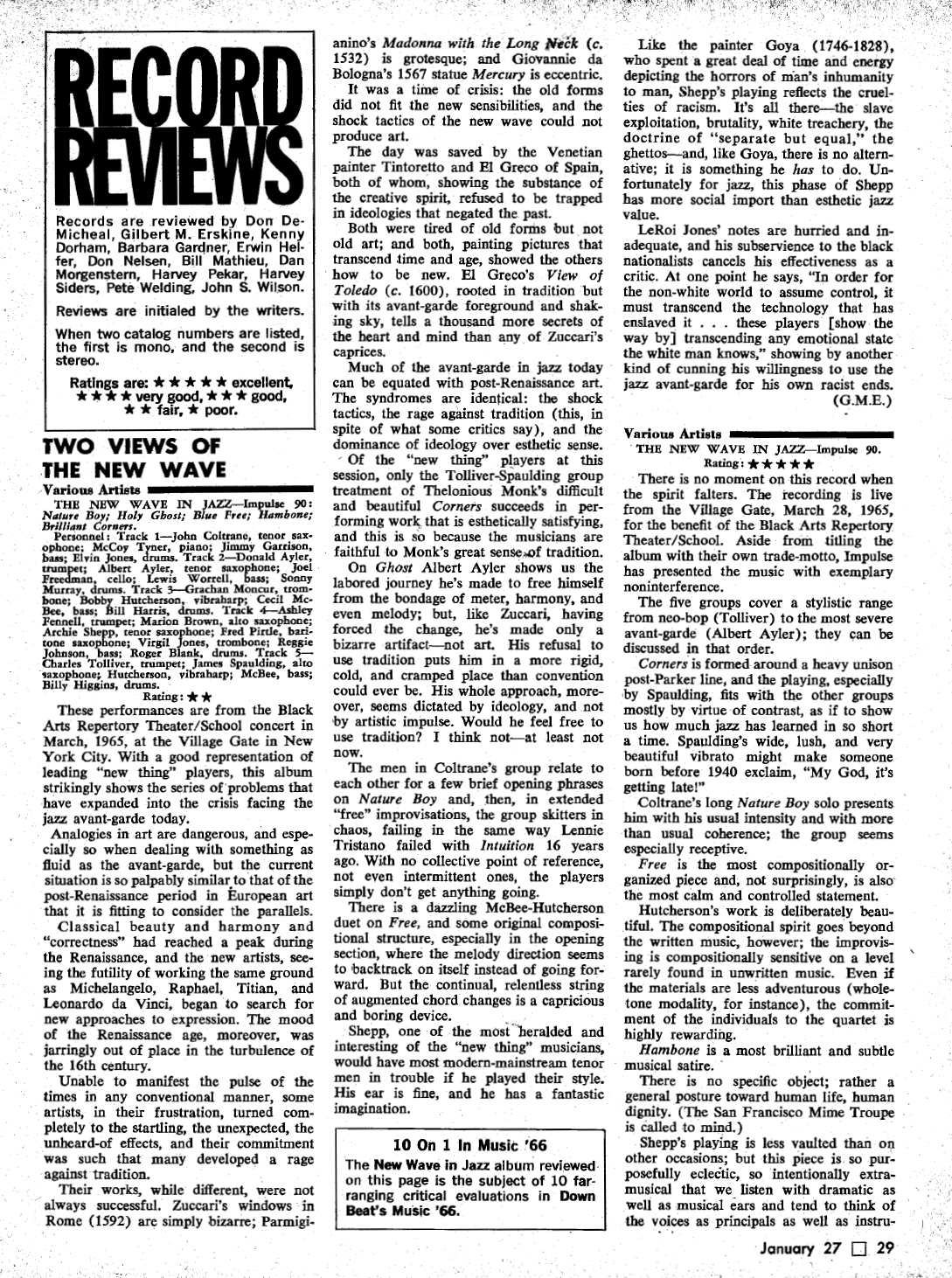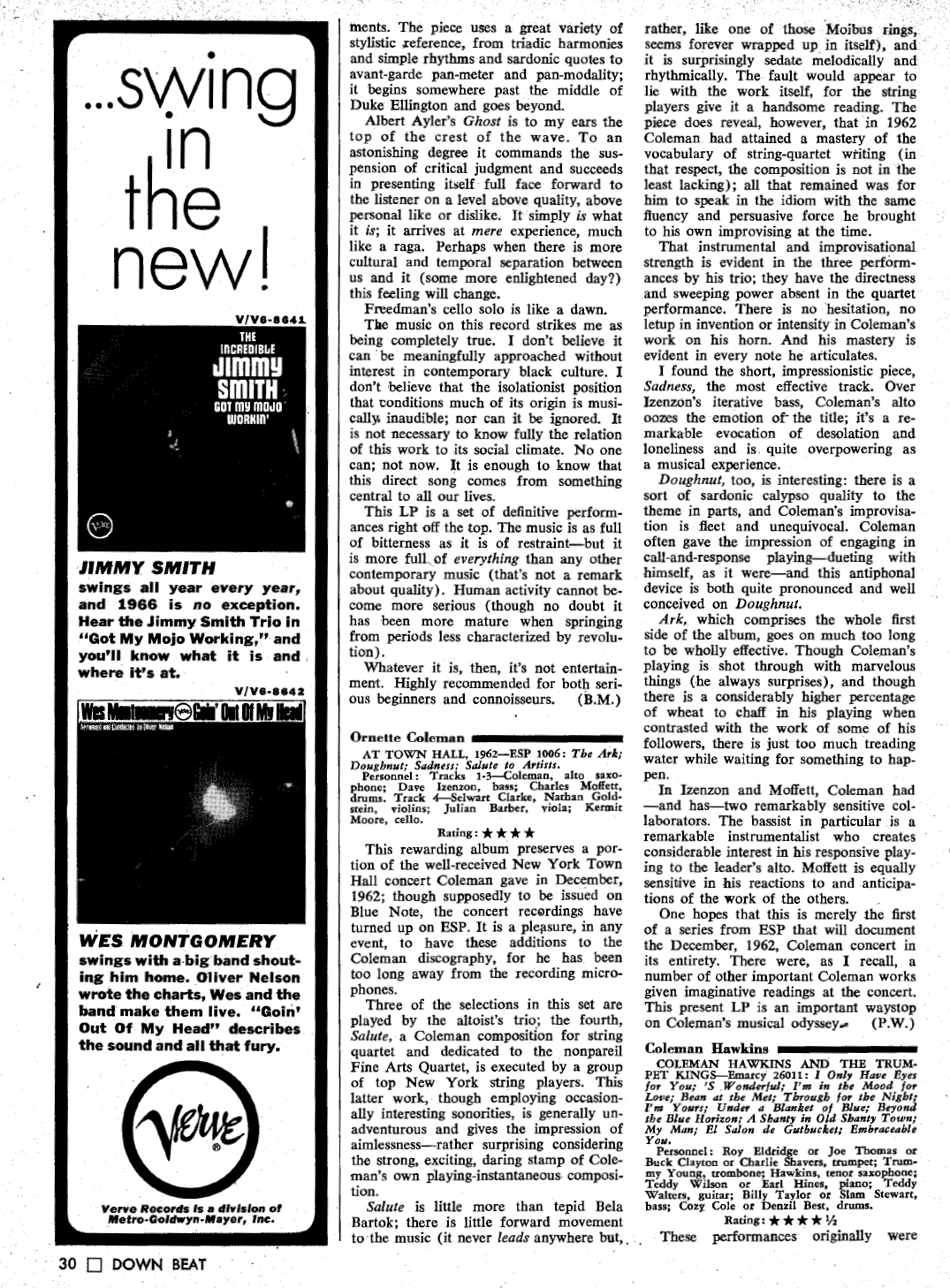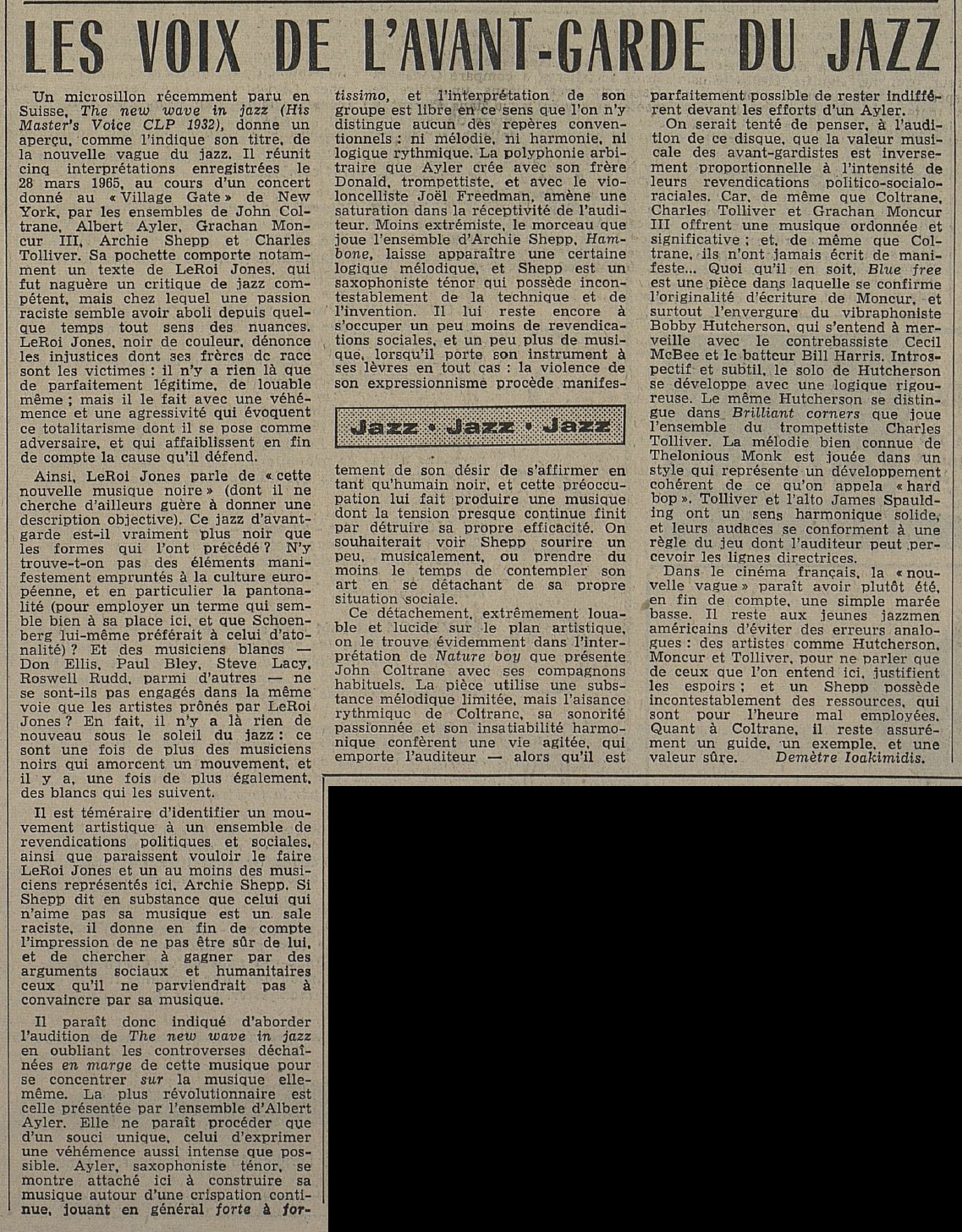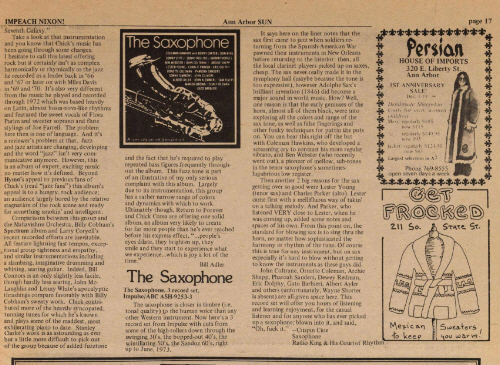|
Music Is The Healing Force Of The Universe The Inconsistency of |
|
|
||||||||||||||||
|
La Saga Héroïque d’Albert Ayler Reevaluations--The Impulse Years
Down Beat (27 January, 1966) - USA |
 |
 |
||
|
Jazz Monthly (April, 1966) - UK NEW WAVE IN JAZZ John Coltrane (ten); McCoy Tyner (p); Jimmy Garrison (bs); Elvin Jones (d) Sound but unremarkable, Nature boy falls into the pattern of recent Coltrane performances, showing once again his formidable rhythmic ease, highly evocative tone, and limited melodic invention. Holy ghost offers a grotesque surface intensity and some challenging percussion work by Murray; along with frantic ensemble passages thickened out by Freedman’s ’cello, the chief impression one takes away is of an almost total lack of melodic resourcefulness. Both horns mix screeching runs with shrill, jabbing single notes at the top of the range without bothering substantially to vary the content of their phrases. This drawback is the more apparent in that there is no regular ground beat and only a perfunctory formal structure. In comparison, Blue free is a far more traditional piece, being similar to the performances included in Moncur’s first Blue Note LP, Evolution. Whereas the trombonist begins well only to run out of inspiration in the later stages of his solo, Hutcherson turns in a delicately introspective solo that grows logically from start to finish. Perhaps the outstanding feature of this track is the entertaining interplay between vibraharp, bass and drums. Bill Harris evinces a combination of verve and self-discipline rare in a newcomer. Could this perhaps be a pseudonym? MICHAEL JAMES *
Tribune de Lausanne (17 April, 1966, p. 12) - Switzerland |
||
 |
|
Negro Digest (September, 1966) - USA In a very real sense, The New Wave in Jazz (Impulse) is a microcosm of jazz history, simultaneously recalling the idiom’s turbulent past and opening doors to what may be the dominant theme in jazz’s future for the next several decades. Many followers will easily recall the transition period of the Forties when a group of young experimenters named John Birks (Dizzy) Gillespie, Thelonius Monk, Charles (Yardbird) Parker, Max Roach and Charles Mingus (and maybe a few others) were toying with a brand new kind of jazz improvisation they called “bop.” After a period of heated controversy about the merits of the new music, bop (and the other forms it influenced) became a respectable and accepted school of learning for jazzmen.
Discography: In Greenwich Village *
La Saga Héroïque d’Albert Ayler
Jazz Magazine (No. 192, September 1971, pp. 40-41) - France La Saga Héroïque d’Albert Ayler: Message From Albert / Free at Last / New Generation (1) / Zion Hill / Love Cry / Universal Indians / Ghosts / Omega / Bells (2) / Holy Ghost (3) / For John Coltrane (4) / Our Prayer (5) / Drudgery / Island Harvest (6). «Saga Héroïque». Pourquoi pas? «La courte histoire du moi transcendant ». Comme certains rencontrent Dieu le samedi soir au quartier latin, d’autres, ceux qui vous parlent dans ce journal, croisent des titres bien curieux. Il faut soit une perversion de l’esprit hors pair, soit un sens de la publicité appris dans les couloirs de la Défense pour entendre cette musique comme un récit mythique cultivant le genre héroïque. Mis à part les mélodies joyeuses d’Armstrong (celui qui portait des petites socquettes blanches) et 1es flonflons enveloppants d’Ellington cuvée «Cotton Club» (celui qui porta encore des grandes chaussettes blanches), je ne connais guère d’exemple de musique plus directe et communicative que celle d’Albert Ayler. «Et tout pour la tripe», comme disait Rabelais. Pour ceux qui ne posséderaient pas les disques dont ce double album est extrait, l’achat est à conseiller sans restriction car, à l’exception des enregistrements publiés par E.s.p., le choix opéré recouvre les expressions multiples d’un art de dire/vivre peu courant sous nos cieux jazzistiques. De plus, on se familiarisera au passage avec les compagnons de route d’A. A., les Cobbs, Graves, Murray, Grimes, Silva, eux-mêmes authentiques créateurs. Plutôt que d’analyser les thèmes du présent album, ce qui a été fait auparavant dans ces colonnes, laissons la parole aux commentaires dissonnants quoique complémentaires imprimés au dos de la pochette... Constantin: «La mort d’A. A. est exemplaire à plus d’un titre... C’est pour cela que la question de savoir qui a tué A. A. est finalement assez subversive et pose le problème de fond d’America the beautiful... La musique d’A. A. est une musique de revanche. Et lorsque cette heure aura sonné, la musique d’A. A. l’Admirable sera étrangement, comme on dit, au goût du jour.» On a ici l’image d’un A. A. «héros de la révolution en marche», ce qui fait marrer lorsque l’on se reporte aux interviews données par A. A., en particulier la conversation entre A. A. et Jacqueline et Daniel Caux. (A propos de Spiritual Unity : «En Amérique ils ont essayé de dire que c’était très politique et que ce serait la cause des émeutes. C’était le moment où j’étais avec LeRoi Jones. Mais ce n’était pas vrai et la musique était très belle.» Art vivant no. 17, février 71. Revue de Mister Maeght, homme bien sous tous rapports.) Ajoutons quand même que, sans vouloir faire d’Albert un Trotsky noir à barbiche, les lunettes et le piolet en moins, on ne peut sans mauvaise foi isoler la naissance et les prolongements d’une telle musique des révoltes individuelles des ghettos et des mouvements noirs de contestation structurés ou non. LeRoi Jones: «A. A. pense que tout est tout. Toute la paix. Tout le mouvement. Qu’il est un réceptacle divin (vessel?) d’où jaillirait l’énergie, point d’émergences. Il pense (ou peut-être ne le pense-t-il pas) qu’il n’est même pas ici... A. A. c’est l’âge atomique.» Honnête vis-à-vis de la philosophie d’A. A., LeRoi Jones, tout au moins dans ce court extrait de ses notes sur A. A., gomme quelque peu la dimension extra-musicale d’Ayler. Ce serait en quelque sorte le contre-pied de Constantin. Sans métaphysique ni politisation pédante, Delfeil de Ton exprime, à mon sens avec plus de bonheur, le poids d’existence d’une telle musique et l’état de joie extrême qu’on a pu éprouver à l’écoute en direct d’A. A. lors de ses deux passages en France. D.d.t.: « A. A. de mes amours, c’est toi que j’aimerai toujours. T’étais le plus beau, c’était toi qui swinguais le plus fort et c’est toi qui les faisais le plus suer... On se tenait par la main Marinella et moi et on était heureux... Que tu sois tombé dans la rivière, on est bien obligé de s’en consoler, mais si ç’avait été de nous, il y en a bien d’autres que l’on aurait poussés à ta place... La terre est encore plus triste depuis que tu n’es plus là... Ils te font des disques In Memoriam. Te voilà embaumé dans le latin. Mon pauvre Albert. Si c’est pas une pitié. » Enfin il nous reste des disques. Ce double album. C’est un peu la fête sous cellophane, mais à l’heure où l’on meurt un peu plus avec l’assassinat des Halles Baltard, Albert même eurubanné c’est toujours une consolation. P. G.-C.
*
Reevaluations--The Impulse Years
Ann Arbor Sun (8 February, 1974) - USA Albert Ayler Albert Ayler: Reevaluations--The Impulse Years. Impulse 9267-2. Archie Shepp tells the story about having finished a set one night and going offstage –– “I remember hearing this huge noise in the room that turned everybody in the room around. It was Albert.” Over three years after his mysterious death in 1970 and close to ten years since he recorded his most influential work, the music of Albert Ayler still turns around the fortunate few who somehow wander within hearing distance. Impulse Records has conceivably made it less random an event that the open-earred human will indeed be within hearing distance sometime with the release of “Albert Ayler, Reevaluations--The Impulse Years.” --Bill Adler.
*
Ann Arbor Sun (No. 57, 30 November / 14 December, 1973 - p.16) - USA |
|||||
 |
|||||
|
|
|||||
|
Home Biography Discography The Music Archives Links What’s New Site Search
|
|||||
